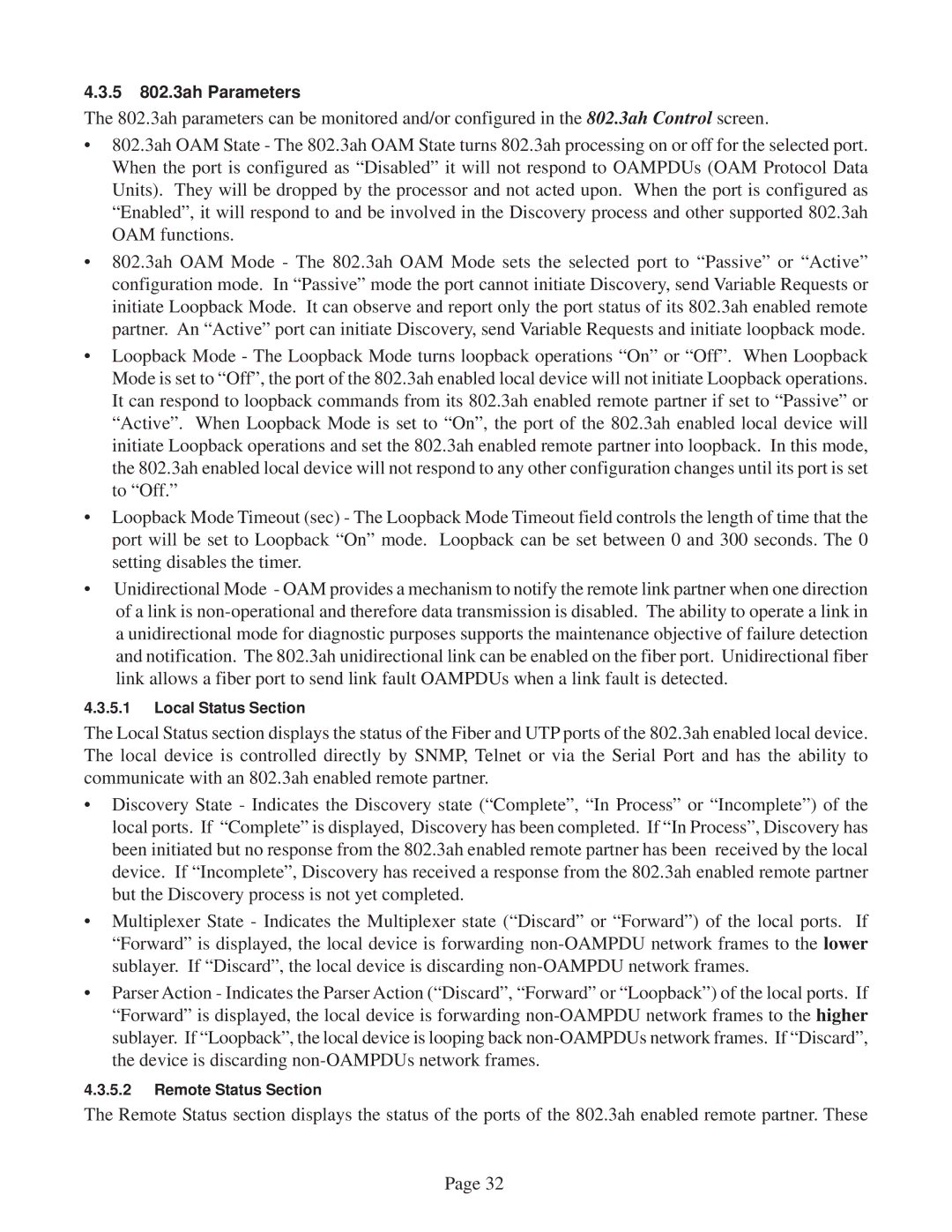4.3.5802.3ah Parameters
The 802.3ah parameters can be monitored and/or configured in the 802.3ah Control screen.
•802.3ah OAM State - The 802.3ah OAM State turns 802.3ah processing on or off for the selected port. When the port is configured as “Disabled” it will not respond to OAMPDUs (OAM Protocol Data Units). They will be dropped by the processor and not acted upon. When the port is configured as “Enabled”, it will respond to and be involved in the Discovery process and other supported 802.3ah OAM functions.
•802.3ah OAM Mode - The 802.3ah OAM Mode sets the selected port to “Passive” or “Active” configuration mode. In “Passive” mode the port cannot initiate Discovery, send Variable Requests or initiate Loopback Mode. It can observe and report only the port status of its 802.3ah enabled remote partner. An “Active” port can initiate Discovery, send Variable Requests and initiate loopback mode.
•Loopback Mode - The Loopback Mode turns loopback operations “On” or “Off”. When Loopback Mode is set to “Off”, the port of the 802.3ah enabled local device will not initiate Loopback operations. It can respond to loopback commands from its 802.3ah enabled remote partner if set to “Passive” or “Active”. When Loopback Mode is set to “On”, the port of the 802.3ah enabled local device will initiate Loopback operations and set the 802.3ah enabled remote partner into loopback. In this mode, the 802.3ah enabled local device will not respond to any other configuration changes until its port is set to “Off.”
•Loopback Mode Timeout (sec) - The Loopback Mode Timeout field controls the length of time that the port will be set to Loopback “On” mode. Loopback can be set between 0 and 300 seconds. The 0 setting disables the timer.
•Unidirectional Mode - OAM provides a mechanism to notify the remote link partner when one direction of a link is
4.3.5.1Local Status Section
The Local Status section displays the status of the Fiber and UTP ports of the 802.3ah enabled local device. The local device is controlled directly by SNMP, Telnet or via the Serial Port and has the ability to communicate with an 802.3ah enabled remote partner.
•Discovery State - Indicates the Discovery state (“Complete”, “In Process” or “Incomplete”) of the local ports. If “Complete” is displayed, Discovery has been completed. If “In Process”, Discovery has been initiated but no response from the 802.3ah enabled remote partner has been received by the local device. If “Incomplete”, Discovery has received a response from the 802.3ah enabled remote partner but the Discovery process is not yet completed.
•Multiplexer State - Indicates the Multiplexer state (“Discard” or “Forward”) of the local ports. If “Forward” is displayed, the local device is forwarding
•Parser Action - Indicates the Parser Action (“Discard”, “Forward” or “Loopback”) of the local ports. If “Forward” is displayed, the local device is forwarding
4.3.5.2Remote Status Section
The Remote Status section displays the status of the ports of the 802.3ah enabled remote partner. These
Page 32
